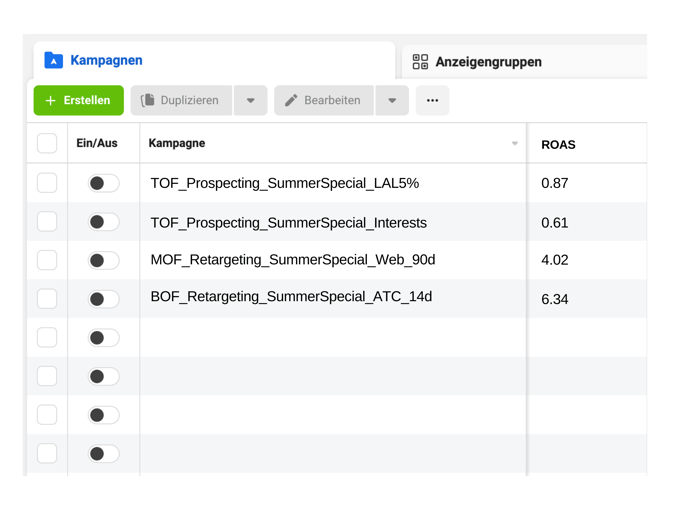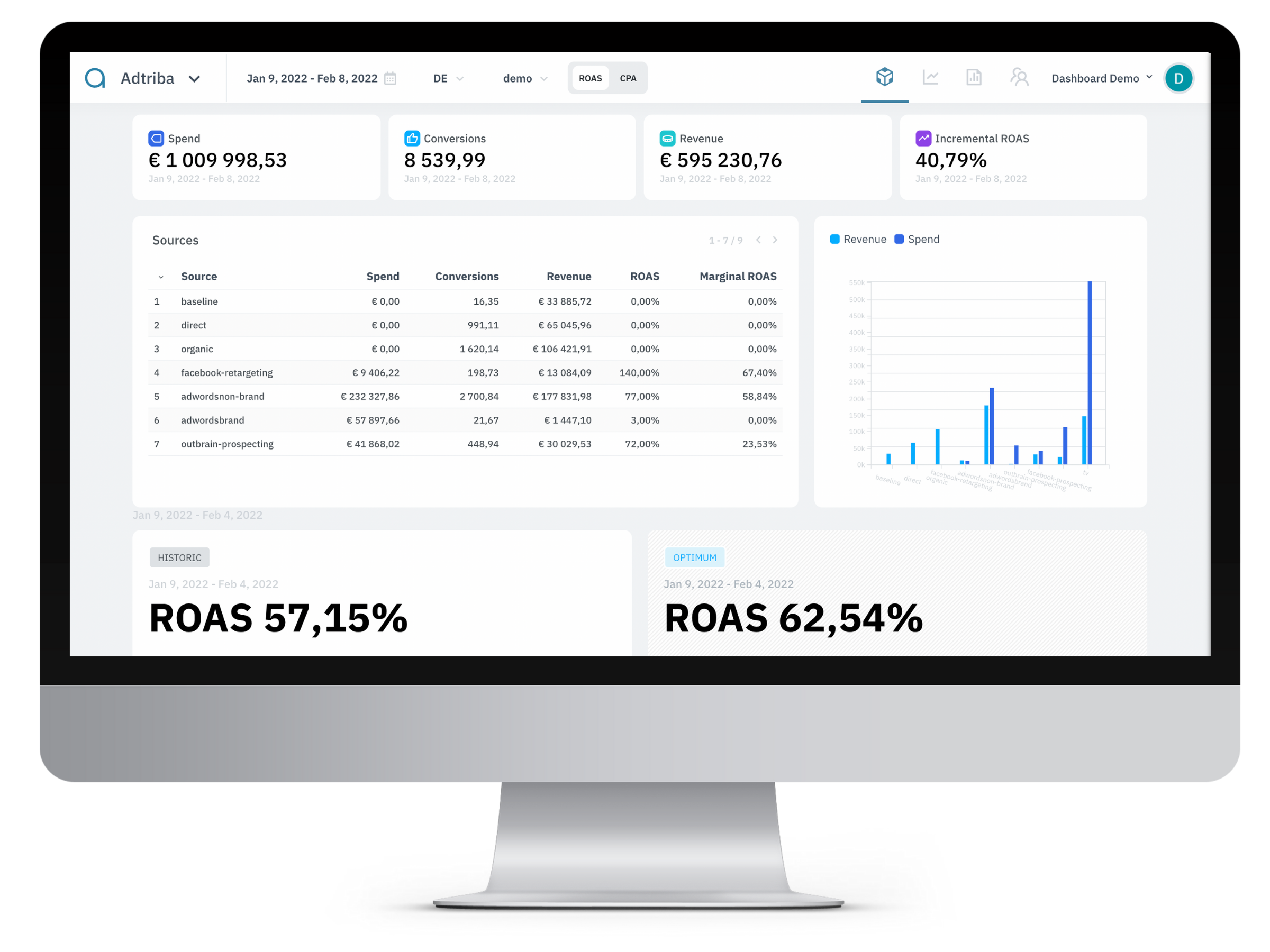Prospecting vs. Retargeting - The Right Budget Split for Maximum ROAS
If you’ve ever allocated budgets in a performance channel you know the struggle to distribute your dollars across campaigns is real. How to strike the right balance between retargeting and prospecting? Your retargeting usually shows a much better ROAS - but you know better than to allocate all of your budget there. If you did, your funnel would dry out in no time.
How to strike the right balance between prospecting and retargeting campaigns on facebook & co? There is a way to do this manually if you manage smaller budgets in a few ad managers. And of course there is help from machine learning if your budget is sky high and your ads are placed in multiple channels. Read along to understand how to use both a simple excel calculation and a sophisticated data-driven setup to boost your ROAS.
Why Lower Prospecting ROAS is Nothing to Worry about
Unless you’re in a business that sells products people buy immediately, after they see them - your prospecting campaigns probably produce lower ROAS than your retargeting campaigns. And rightly so! The whole purpose of prospecting campaigns is to introduce your products to a “cold” audience - people who haven’t heard of your brand or products before. Or - for more seasoned targeting - people who have seen your ads before but long enough ago that they surely forgot about them in the meantime.
When you introduce people to a brand or a product they most likely will not buy immediately. Just think of yourself seeing an ad for a nice pair of shoes - you might still simply scroll by. If it’s the advertiser’s lucky day, you might click through to the webpage and browse the product palette. But let’s be honest, most probably you’re not in a place / mood / wallet situation / *fill in your reason* to buy right now.
However, if you hadn’t been introduced to the brand with this ad or even multiple of them then the chances of you buying or even discovering the brand through another platform would be much lower.
Therefore advertisers really shouldn’t worry about a lower Prospecting ROAS even if most of the media budget is spent in those top of funnel campaigns - they will feed the retargeting pools and pay off after all.
How Retargeting ROAS Makes Your Prospecting Look Bad
Retargeting can function as both a middle or a bottom of funnel advertising tactic: By retargeting website visitors marketers aim to re-engage an audience who bounced off the website. By showing ads to people who visited product pages or even added something to their cart without checking out yet, a bottom of funnel tactic comes into place.
In general the purpose of retargeting is to close an already warm prospect. Therefore, you probably observe a much better ROAS for your retargeting campaigns. In fact, your reports probably look something like this:

Your first instinct might tell you to switch off campaign TOF_Prospecting_SummerSpecial_Interests immediately. The ROAS looks horrible and you feel as if this campaign eats up all your precious media budget! However, we strongly recommend not to rely on gut feelings when it comes to quantitative decision making. Humans have a hard time analyzing large amounts of data and detecting patterns in it. It’s exactly what it needs though, to strike the right balance between prospecting and retargeting. After all, successful marketing comes down to your overall business and sales not to single campaigns. And although it feels bad to see a 0.x ROAS on prospecting campaigns, logically you know they set up your retargeting campaigns for success.
Would be great to have a bit more confidence in it, though - right? Knowing something logically is one thing - having data evidence to back up that you really did your best and understand where to improve would help a lot more.
Therefore, let’s have a look at how knowing your numbers will help you know exactly whether your current budget is spent in favor of your business goals.
Know Your Numbers: Break Even Point & CPA
Now what to do now that you know a lower ROAS for Prospecting is nothing to worry about but you still want to maximize your overall ROAS? How to strike the right balance between the funnel stages?
When you have a seasoned business to optimize you need to decide how you want to split your budgets between the two tactics. A simple and popular rule of thumb is to put 80% into prospecting and 20% into retargeting. This is extremely generic and will most certainly not deliver the best results. To allocate your budget in the most effective way, you need to do a bit of calculation on top of the numbers available to you in the business manager reports.
This is important because you need to find out how much you can afford to spend to acquire a customer. This is indicated by the break even point and here is how to calculate it:
First - know your average order value (AOV). It’s as simple as dividing your overall revenue by the sum of all conversions. Then apply your profit margin to it. You can calculate it yourself [(revenue - expenses) divided by revenue )* 100] or you can request this from your business unit.

Your break even point is at AOV*Profit Margin. This results in the maximum cost at which you should acquire a customer (customer acquisition cost = CPA). If you go above this point with your acquisition cost you simply pay more to get a sale than you earn with this sale.
Alright, now what the heck does this have to do with allocating budget in prospecting vs. retargeting? Observing the CPA in a channel over time will help you decide when to increase or decrease the ratio between prospecting and retargeting.
The Balancing Act Between Prospecting and Retargeting
The better retargeting works for you the more budget you can afford to allocate into prospecting, expecting it to feed retargeting even further.
Doing this, however, will increase your CPA - the cost at which you acquire the new customers. This can be expected because you address a larger audience (or the same audience at a higher frequency) which decreases the probability of conversion. You can tolerate this rising CPA as long as it stays below your break even point. As soon as you go above the break even point, you should decrease your prospecting spend and allocate more into retargeting to harvest your warmed up prospects.
Another question that comes to mind is when to cut off the investment or change up the campaigns? After all, this up and down game can only go so far with the same creative and targeted audience. To decide this you need to check the engagement coming from your prospecting traffic. If people bounce off your website, don’t look at products or don’t interact in some other way with your site - most likely putting more money into retargeting will not be enough to convert them.
Let Machine Learning Take the Pressure off Your Shoulders
Surely this calculation is not something that needs to be performed only once. The size of your addressable audience will fluctuate over time as prospects progress through the buying cycle. This needs to be reflected in your budget allocation accordingly - ideally on a weekly basis.
Doing all this - calculating the CPA, juggling and balancing the budget is tedious manual effort which is prone to mistakes at the very least. While it’s very useful to have performed this calculation yourself to fully understand the reasoning behind it, you don’t have to hire another person in the team just to cover the effort.
 Screenshot from Adtriba's dashboard showing results and insights from machine learning analysis of your business.
Screenshot from Adtriba's dashboard showing results and insights from machine learning analysis of your business.
With a scientific approach and an independent data-driven attribution vendor all this work is done by machine learning algorithms for you. Seeing different acquisition costs by channel and campaign in a coherent dashboard lifts manual effort off of your shoulders. Receiving recommendations on where to put your budget to maximize revenue saves time and gives you confidence in your decisions backed by data.
Conclusion
When it comes to prospecting and retargeting tactics as part of your programmatic advertising - it’s not one over the other and it’s not trivial to strike the right balance between the two. You need to target the whole marketing funnel and connect the dots in your customers’ journeys. This goes beyond popular rules of thumb like 80% into prospecting and 20% into retargeting.
Knowing your break event point indicates the maximum cost you can afford to spend on customer acquisition in a channel. Knowing this cost and observing it over time will give you a pretty good idea of when to increase or decrease prospecting and retargeting budgets. However, it’s a tedious act to perform when you manage multiple channels and higher media budgets. Therefore, we recommend that you let machine learning do the heavy lifting for you. An independent measurement vendor enables you to get the necessary transparency into your numbers to make budget decisions and will even prompt you with suggestions on how to optimally spend your budget to maximize ROAS.
Want to learn more about smart budget allocation with the help of machine learning? Our customer DIE ZEIT performs this amazingly and manages to reduce their customer acquisitions costs and increase ROAS though correct evaluation of their retargeting activities. Read the case study, to learn more!
See how the right balance between Retargeting and Prospecting will look like for your channels! Book a free call with one of our experts.